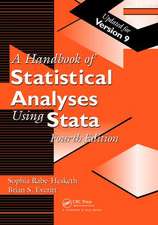A Handbook of Statistical Analyses using SAS
Autor Geoff Der, Brian S. Everitten Limba Engleză Paperback – 20 dec 2008
With the data sets and SAS code available online, this book remains the go-to resource for learning how to use SAS for many kinds of statistical analysis. It serves as a stepping stone to the wider resources available to SAS users.
| Toate formatele și edițiile | Preț | Express |
|---|---|---|
| Paperback (1) | 462.17 lei 6-8 săpt. | |
| CRC Press – 20 dec 2008 | 462.17 lei 6-8 săpt. | |
| Hardback (1) | 1042.56 lei 6-8 săpt. | |
| CRC Press – 15 noi 2017 | 1042.56 lei 6-8 săpt. |
Preț: 462.17 lei
Preț vechi: 593.40 lei
-22% Nou
Puncte Express: 693
Preț estimativ în valută:
88.45€ • 91.100$ • 73.02£
88.45€ • 91.100$ • 73.02£
Carte tipărită la comandă
Livrare economică 12-26 aprilie
Preluare comenzi: 021 569.72.76
Specificații
ISBN-13: 9781584887843
ISBN-10: 1584887842
Pagini: 416
Ilustrații: 77 black & white illustrations, 117 black & white tables
Dimensiuni: 156 x 234 x 25 mm
Greutate: 0.75 kg
Ediția:Revizuită
Editura: CRC Press
Colecția Chapman and Hall/CRC
ISBN-10: 1584887842
Pagini: 416
Ilustrații: 77 black & white illustrations, 117 black & white tables
Dimensiuni: 156 x 234 x 25 mm
Greutate: 0.75 kg
Ediția:Revizuită
Editura: CRC Press
Colecția Chapman and Hall/CRC
Public țintă
Professional Practice & DevelopmentCuprins
Introduction to SAS. Data Description and Simple Inference: Mortality and Water Hardness in the United Kingdom. Simple Inference for Categorical Data: From Sandflies to Organic Particulates in the Air. Analysis of Variance I: Treating Hypertension. Analysis of Variance II: School Attendance among Australian Children. Simple Linear Regression: Alcohol Consumption and Cirrhosis Deaths and How Old Is the Universe? Multiple Regression: Determinants of the Crime Rate in States of the United States. Logistic Regression: Psychiatry Screening, Plasma Proteins, Danish Do-It-Yourself, and Lower Back Pain. Generalized Linear Models: Polyposis and School Attendance among Australian School Children. Generalized Additive Models: Burning Rubber and Air Pollution in the United States. Analysis of Variance of Repeated Measures Visual Acuity. Longitudinal Data I: Treatment of Postnatal Depression. Longitudinal Data II: Linear Mixed Models. Longitudinal Data III: Generalized Estimating Equations and Generalized Mixed Models. Survival Analysis: Gastric Cancer, the Treatment of Heroin Addicts, and Heart Transplants. Principal Components Analysis and Factor Analysis: Olympic Decathlon and Statements about Pain. Cluster Analysis: Air Pollution in the United States. Discriminant Function Analysis: Classifying Tibetan Skulls. Correspondence Analysis: Smoking and Motherhood, Sex and the Single Girl, and European Stereotypes. Appendix. References. Index.
Notă biografică
Geoff Der works as a consulting statistician at the Medical Research Council Social and Public Health Sciences Unit in Glasgow, Scotland. His current research interests include the relationship between cognitive functioning and health, income and health, and models for longitudinal data.
In 2005, Brian S. Everitt retired from being head of the Department of Biostatistics and Computing in the Institute of Psychiatry at King’s College London, UK. Currently working on his 60th statistics book, he acts as a statistical consultant to a number of companies.
In 2005, Brian S. Everitt retired from being head of the Department of Biostatistics and Computing in the Institute of Psychiatry at King’s College London, UK. Currently working on his 60th statistics book, he acts as a statistical consultant to a number of companies.
Recenzii
… this edition has new chapters for simple linear regression, generalized additive models, generalized estimating equations and generalized mixed models. Chapters have been re-arranged to fit the content better. The SAS outputs are more compact and easier to follow … This edition also incorporates some of the latest features, such as the enriched Output Delivery System, in version 9.2 of SAS. Overall, the book provides an effective way for researchers and students to quickly identify the appropriate statistical methods for their research, manipulate datasets, write up the basic framework of SAS codes and interpret the SAS output. … a valuable resource for any researcher or student who wants to learn the basics about various statistical analyses covered in the book or for anyone involved in statistical consulting or in applied statistical analysis. …
—Pharmaceutical Statistics, 2011
…Overall, the structure that was chosen by the authors is effective in making the reading entertaining and engaging. The third edition of this handbook will prove to be an extremely useful reference tool for current and future SAS users.
—Antonio Pinon, Barclays, Journal of the Royal Statistical Society, Series A, 2010
… Like the first two editions, this edition emphasizes how to conduct a range of statistical analyses using the latest version of SAS, version 9.2. … I think the authors did a nice job in achieving the targeted goal. The SAS programs and data used in this edition are available online. The Output Delivery System (ODS), the new graphic procedures, and ODS graphics can be used for presenting the results. I expect that SAS users will appreciate this feature of the edition. … In summary, SAS users will find the new edition quite useful.
—Technometrics, November 2009, Vol. 51, No. 4
…The authors largely succeed in the content of the book, expanding on the second edition of the book with practical examples of modeling and graphing techniques that have been added to SAS in recent years. They cover a wide range of topics efficiently—the explanations are brief, but not overly simplistic; the examples are sufficient and never excessive. … this a good resource for the user who is acquainted with the very basics of SAS, but unsure of how to conduct analysis. …
—Journal of Statistical Software, April 2009
…The major distinction between this edition and previous versions is that this edition uses new procedures that are available in SAS version 9.2 to make data analysis easier and to provide results that are ready for publication through the output delivery system (ODS), the new graphics procedures, and ODS graphics. … This book combines data management using the SAS system and data analysis into one book. … There are many positive aspects of the book. It is a great reference for someone who is already familiar with the SAS language and the statistical techniques. It cuts out all of the intricate detail and gets to the basic steps needed to perform a particular analysis. The book has shortcuts to reduce the time spent on common tasks. It also has an excellent introduction to the new graphical capabilities of SAS V9.2, which would elate anyone who has used previous versions of SAS graphics by the inclusion of new capabilities.
—Clinical Trials, 2009
Praise for the Second Edition
… a simple manual for using SAS. It has put thousands of pages of SAS manuals in less than 400 pages of a paperback … The authors have again done an excellent job of explaining each statement as well as the resulting output … In summary, the handbook introduces SAS programming through a number of data sets of varied complexity, makes the data sets suitable for analysis through programming statements, then uses SAS procedures for analysis. SAS procedures and the resulting outputs are properly explained and suggestions for appropriate analyses are provided where necessary. … an excellent handbook for a beginning SAS user. Statisticians and nonstatisticians can both benefit from this book.
—The American Statistician, November 2002
—Pharmaceutical Statistics, 2011
…Overall, the structure that was chosen by the authors is effective in making the reading entertaining and engaging. The third edition of this handbook will prove to be an extremely useful reference tool for current and future SAS users.
—Antonio Pinon, Barclays, Journal of the Royal Statistical Society, Series A, 2010
… Like the first two editions, this edition emphasizes how to conduct a range of statistical analyses using the latest version of SAS, version 9.2. … I think the authors did a nice job in achieving the targeted goal. The SAS programs and data used in this edition are available online. The Output Delivery System (ODS), the new graphic procedures, and ODS graphics can be used for presenting the results. I expect that SAS users will appreciate this feature of the edition. … In summary, SAS users will find the new edition quite useful.
—Technometrics, November 2009, Vol. 51, No. 4
…The authors largely succeed in the content of the book, expanding on the second edition of the book with practical examples of modeling and graphing techniques that have been added to SAS in recent years. They cover a wide range of topics efficiently—the explanations are brief, but not overly simplistic; the examples are sufficient and never excessive. … this a good resource for the user who is acquainted with the very basics of SAS, but unsure of how to conduct analysis. …
—Journal of Statistical Software, April 2009
…The major distinction between this edition and previous versions is that this edition uses new procedures that are available in SAS version 9.2 to make data analysis easier and to provide results that are ready for publication through the output delivery system (ODS), the new graphics procedures, and ODS graphics. … This book combines data management using the SAS system and data analysis into one book. … There are many positive aspects of the book. It is a great reference for someone who is already familiar with the SAS language and the statistical techniques. It cuts out all of the intricate detail and gets to the basic steps needed to perform a particular analysis. The book has shortcuts to reduce the time spent on common tasks. It also has an excellent introduction to the new graphical capabilities of SAS V9.2, which would elate anyone who has used previous versions of SAS graphics by the inclusion of new capabilities.
—Clinical Trials, 2009
Praise for the Second Edition
… a simple manual for using SAS. It has put thousands of pages of SAS manuals in less than 400 pages of a paperback … The authors have again done an excellent job of explaining each statement as well as the resulting output … In summary, the handbook introduces SAS programming through a number of data sets of varied complexity, makes the data sets suitable for analysis through programming statements, then uses SAS procedures for analysis. SAS procedures and the resulting outputs are properly explained and suggestions for appropriate analyses are provided where necessary. … an excellent handbook for a beginning SAS user. Statisticians and nonstatisticians can both benefit from this book.
—The American Statistician, November 2002
Descriere
Remaining the go-to resource for learning how to use SAS for many kinds of statistical analysis, this third edition of a bestseller explains how to conduct a range of statistical analyses using the latest version of SAS. It illustrates each type of analysis with numerous real-world data examples, such as environmental causes of diseases, hypertension treatment, and gastric cancer treatment. This edition presents the new graphics procedures of SAS 9.2. It also includes more end-of-chapter exercises and selected answers in the appendix, along with a solutions manual that provides SAS code, output, and comments. The SAS programs and data sets used in the book are available online.




















